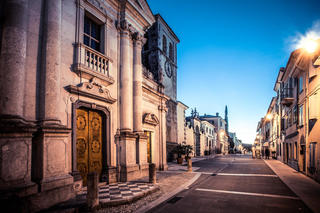
It is the largest church of Gradisca and an example of Baroque architecture in the region. Initially dedicated to San Salvatore, since 1789 it has been dedicated to the patron saints of the city.
The building is the result of various transformations. Existing with certainty as early as 1342, it was only during the Eggenberg period (1647-1717) that the church acquired monumentality, thanks to a notable enlargement with the incorporation of the nearby Torriani chapel and a new façade.
Divided into three parts, the current stone façade is the work of the mid-700s of architect Paolo Zuliani. The central part, where the main portal is located, is marked by giant semi-columns, resting on high plinths; the whole is concluded by a broken pediment. The two lower side parts are connected to the middle one by scrolls decorated with festoons of flowers and fruit; on the left wing there is the statue of Fertility, and on the right wing the statue of Hope. Also in the mid-1700s the new bell tower was erected.
Internally, the three naves are separated by slender columns with round arches. The main altar was designed and built by Leonardo Pacassi in 1690. The two statues on either side of the sixteenth-century altarpiece with the Resurrection portray Saints Pietro and Paolo. At the beginning of the 18th century the presbytery was decorated with frescoes by Giulio Quaglio; surviving fragments are kept in the civic museum. The interior of the church was heavily restored in 1980.
